Adventures in Bhutan
CAPI's Associate Director Helen Lansdowne is currently on secondment in the role of Assistant Dean for the Climate Change & Environmental Law Centre at the Jigme Singye Wangchuck School of Law, Bhutan.
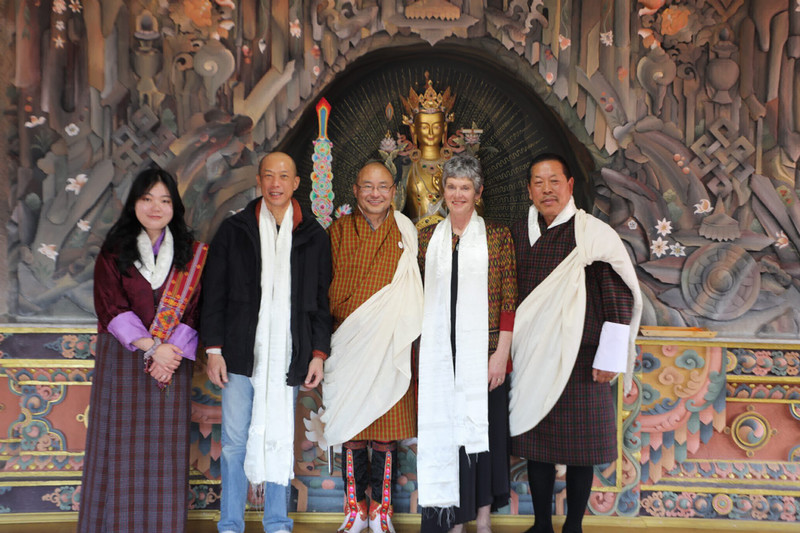

Temple Visiting on a Sunday in Paro
A few weekends ago, several of my colleagues suggested that we spend a Sunday afternoon visiting some temples. We had talked about hiking to a few temples but when the group assembled to start our adventure, I noticed that two of my colleagues were dressed in their kiras carrying shopping bags of food offerings for the monks. Their shoes were not quite as glamourous as what is usually worn, but neither were they hiking boots or runners. I became suspicious of what we were off to do, I in my hiking boots, pants, and an old t-shirt.
Off we drove up a beautiful mountain road full of blooming hydrangeas, the last of the wild roses and many other hedgerow plants I could not identify. After about an hour of climbing we came to a dirt driveway with a sign directing us to the first temple. The entrance was unlike any temple entrance I had seen to date. And here before moving on with my description I want to point out that although there may seem to be a classic understanding of a Buddhist temple in Bhutan, there are many variations such as the one I was about to enter. The gate was magnificent, a solid door made from huge timbers flanked by dry rock walls that had been newly created. Inside the gate was a large compound with many recently planted fruit trees and colourful beds of lilies, roses, flowering shrubs, all very tidy and tended. Across the lawn was a geo-dome tent set up as a café and that is where we headed. On route we met an elderly monk who was busy pruning back the deadwood on a camelia and a much younger monk who welcomed us into the café offering coffee and many different types of tea. We sat sipping and talking, discovering that most of the resident monks were away from the monastery doing studies abroad. The head Lama, however, was in residence and the young monk offered to find out if we could meet him. This Lama is thought to be the reincarnate of one of the past principal teachers of the current Dali Lama, consequently, he is held in high regard both in Bhutan and abroad.

About fifteen minutes into our tea, we were summoned to go towards the temple where we would meet the Lama. I don’t know what my misconceived ideas were as to what or who this lama would be but upon meeting him, I found a young man in his early forties with an open smile and easy manner as he welcomed us not only to the temple but also to a standing museum behind the temple. All sorts of tools, baskets, and other collected items were hanging in and on a wooden structure which, as we learned, had been built from the weathered doors and windows from the old temple that once stood on the property.

The Lama took us into the temple after having explained that it was recently built, the old temple that was once in its place too old and decrepit to save. This temple houses Tara, the bodhisattva or goddess who grants wishes. The Lama explained that he formerly worshipped the bodhisattva of wisdom but had turned his attention more recently to Tara. Tara is a beautiful goddess, luscious, full bodied and enticing. Look at her picture, it is not hard to understand why she would be worshipped:

The Lama although committed to Tara, has not left behind his firm belief in wisdom. He is a progressive Lama who believes in providing his monks with educational opportunities. In fact, the 40 or more monks who were not in residence the day we visited where away in far flung places studying, a common practice for this group, as the Lama stressed that six months of the year are devoted to outside study. Education is of primary importance and the Lama makes sure that all who are part of his world will learn and become educated.
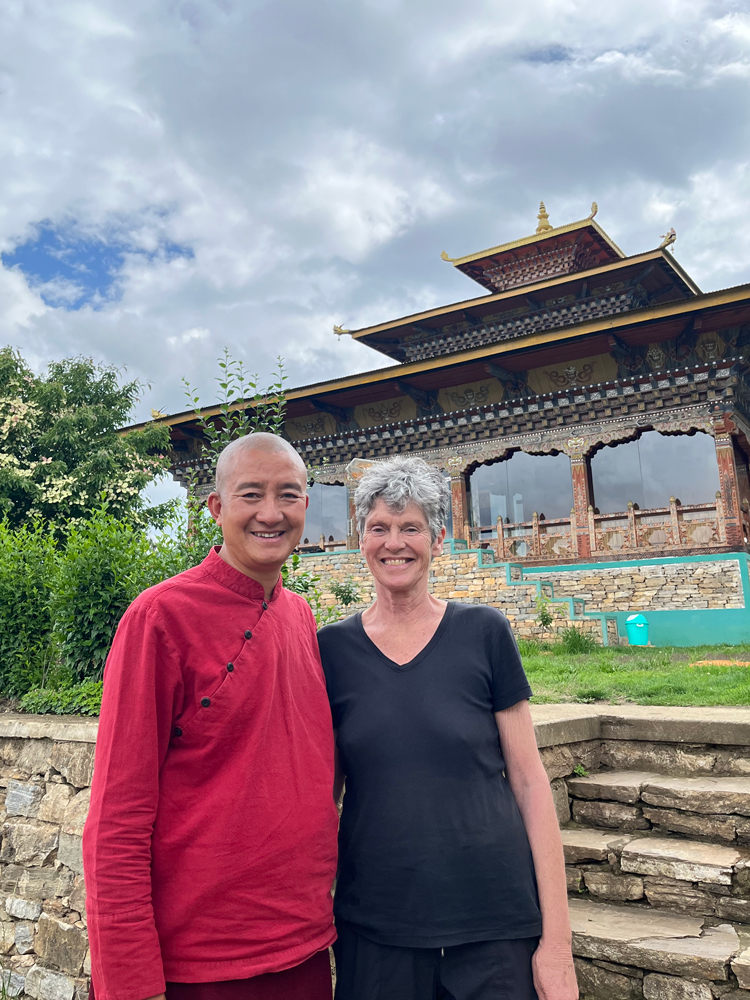
There were young children flying around everywhere or so it seemed. The Lama’s cousin’s children were visiting as summer vacation had started. They took me for a walk to show me the dog and cat houses as well as the outdoor fitness equipment that had been recently installed by the WHO. Everything was perfectly in order, all was clean and neat.
We finished our visit and headed down the dirt road towards Paro. A circle route that offered us another temple visit. This one, not more than two kilometers away, was the absolute opposite of where we had been. While the Tara temple was large, spacious, bright, and full of light, this next temple was accessed by climbing a very steep wooden ladder to the top of a small temple building. The temple itself had little light and was infused with dark wood, deities, bodhisattvas’ and a buddha. This is an old temple that has been cared for by a family, now three generations, who live in a contiguous dwelling and the patriarch of the family was our host. The temple was small by any standard but seemed even smaller after the Tara Temple. At one point I looked down at the floor and realized that we were standing on huge, wide timber planks that are a testament to the size of the trees that use to prevail in the local forests many centuries ago. Again, in contrast with the Tara Temple, the gardens outside the old temple were a riot of colour, not manicured but left to nature’s devices.
We sat outside the temple gate in the last of the sun having our tea and taking in the view. I kept thinking of the contrast between our two temple visits. Two very different spiritual dwellings, offering similar but very different presentations of Buddhist temples.
Blog 1: April 2024
Settling In
In Dione Brand’s seminal work, A Door of No Return, the author observes that a person starts their travels long before they leave. A journey begins in the mind: created spaces, landscapes, colours, people, images conjured up by what you imagine, dream or perhaps read beforehand. I too travelled to Bhutan many times in my imagination long before I left Canada. But this was not my first trip to Bhutan as I had traveled there in 2019 just before our COVID years. My trip was short, and a conference filled up most of the space. However, I did have memories, but my experience was nothing like what was awaiting me. I arrived at JSW School of Law and was taken to my residence, a one-story bungalow that is part of a housing complex attached to the University. Just to set the record straight, the Law School is not in the capital city of Thimpu where I had gone previously. The Law School is in fact in the village of Pangbisa, a small farming community that stretches both below where the school is located and above. My new abode is nestled in a pine forest on the side of a mountain, the natural surroundings are profoundly beautiful. Two weeks into my stay the sun had warmed up the landscape enough to bring to life wild purple primulas and fragrant daphne bushes. My walk to work, which takes just over ten minutes, has stunning views of the Paro Valley and immediate forests filled with songbirds and on occasion langurs. At night the only sounds are the dogs barking, usually trying to fend off the wild boars that visit the local farm fields to forage. And it is dark, not a light to be found. The other aspect of my new world that I had not appreciated in my imaginings is the utter unabashed hospitality that I have experienced. I had thought that my colleagues might be friendly and helpful to the outsider who has joined their world, but I didn’t expect my farm neighbours to be so friendly and welcoming. I usually take a walk everyday with my binoculars slung over my neck, seeking the elusive bird that is singing but not in my line of vision. One day I wandered down the road and stopped to look at a bird in the distance. An old farmer stood watching me and when I had started to walk further motioned me into his farmyard. I was greeted by a wide grin and head nodding, I not being conversant in Dzongkha and he not able to speak English. A moment later his granddaughter appeared, the main farmer in the family. We chatted together about where I had come from, up the road and attached to the Law School. I asked about her farming and immediately she took me inside her makeshift greenhouse where seedlings were growing ready to be planted out. She started pulling out the largest bok choi plants from one area, a whole armload and said they would be good for my supper. Our next stop was the oil press building where the granddaughter showed me the mustard seed oil press that the family runs and the villagers use during pressing season. I was immediately handed two bottles of mustard seed oil with instructions to use it regularly as it is not only great to cook with but also medicinal. I thanked her profusely and we both said goodbye as though we had been neighbours for a while. Here I am in my new, temporary home that strikes me with awe every time I step outdoors.

Paro Tshetshu

Every year each region in Bhutan, or what is known as a Dzong, has its own auspicious date in the Buddhist calendar when it celebrates its Tshetshu or festival. I live in the village of Pangbisa which is in the Paro Dzong, and this past weekend was the Paro Tshetshu. I along with two thousand other attendees made our way up to the Dzong (temple) located in the heart of Paro, climbing hundreds of steps to arrive at the open area where the festivities are held. What an extravaganza in so many ways. Colours arraigned everywhere as the richness of the kiras and ghos met one’s eyes. These are the traditional clothing for both women and men that are worn everyday but on the days of the Tsehtshu, only the finest are worn. The Kira is a woven piece of fabric that for the festival usually has a richness of both colour and tapestry. The gho is the men’s outfit that is also woven with bright threads to maximize the effect. Looking across at the hillside where a thousand people were sitting high above the stage to take in the show, was a ribbon of colour.
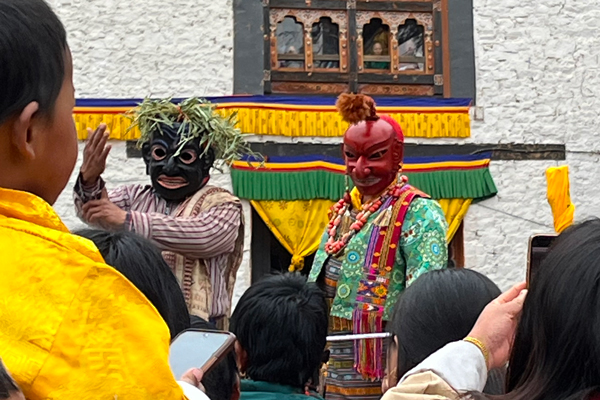
I attended days two and three, both extremely different but both spectacular. On day two the monks of the Paro Dzong danced the Dance of Dead in which a human is brought before the God of Dead for judgement. A prosecutor appears as too a defense lawyer, along with an army of masked dancers sporting different animal masks, offering the many ways that a person can be reincarnated. The dance is both meditative with slow moving circular motions as well as acrobatic with high kicks and jostling. The God of the Dead is an enormous, masked devil that is wheeled out and paraded around the stage before being deposited on a throne. Throughout the entire dance, which lasts two hours, three jesters are busy poking fun at the performers through amplified yells and lurid motions. This dance is not only about entertaining the crowds, but it is also about redemption, seeking a blessing to wash away your sins and a long line of people quickly formed to attend to their absolutions. I found myself mesmerized by the colours of the costumes, the amazing masks and the motion of the dance. Time flew by and before I knew it I, along with my two companions, were making our way out of the Dzong to seek a meal in Paro. Day three of the Tshetshu could not have been more different. Day two the sun shone down, and the grounds got hot. Day three the clouds moved in and by noon it was raining. Day two was a day of high drama with the dances. Day three was about the Thongdrel, an enormous three storey scroll depicting images of Buddha that is unfurled at 3 am and then ceremoniously rolled back up typically at sunrise and taken back to the Dzong until the next year. While the Thongdrel is hanging it is the time for blessings and many people of Paro make the trek to the Dzong to get in place to see the Thongdrel unfurled and then receive their blessings while it is on display. There are dances and jesters, but the main show is the Thongdrel. We were lucky because the scroll was still hanging when we arrived at 8:00 am and was not taken down until around 10:00. What I experienced during my second day at the Tshetshu was the wonderful spirit of companionship among everyone. People work their way to the front of the crowd without anyone minding, bums shifting over to make room for one more. People chat away for hours, strangers meeting for the first time but finding common ground to keep talking. I was sitting between two older women, neither of whom spoke English but that did not stop us from all agreeing that sitting on the wet ground at our age for hours at a time was a feat in of itself. We shared umbrellas, juice boxes and anything else that would add to our pleasure of being part of the show.
Blog 2: May 2024
Spring in Bhutan
Spring in Bhutan, particularly the two months of April and May, are when people travel. By the end of May the monsoon rains begin and will last throughout the summer, making movement difficult. Roads can be shut because of landslides or flooding, leading to travel unpredictability. I, along with many others, took to the roads and trails in these past six weeks. In April I joined an entourage of legal scholars who were traveling together in the mountain range of Dagala. Their trekking was an opportunity to spend time together talking about their latest joint publication. I persuaded them to let me join and while they talked about different judicial systems and how laws play out in various locales, I did my bird watching and plant hunting. Five days in the mountains traveling from 2500m to 4350m (at the highest point). Spectacular alpine scenery with a shortage of oxygen leaving one breathless with each step. On the second day of our trek snow started to fall and the temperature dropped. Sleeping in our respective tents was out of the question. The solution – sleep in a yak herders hut and hope that the ten bodies would bring enough heat to get us through the night.

The next morning brought beautiful vistas of snow sprinkled mountains – all the valleys and craggy moraines stood out brilliantly. On this day, we walked to five lakes that are part of the 1000 lake region of Dagala. There are not actually 1000 lakes, closer to 100 but the romance of the scenery and myths of the region make it seem as though 1000 lakes could be found. Off we started, I ahead with one of our guides, a young horse handler who was from the region and knew how to trek in this landscape with his eyes closed. I trotted along after him sucking in air to try to fill my lungs. Suddenly we arrived at the first lake. He took my picture and I one of him, I sat down to enjoy the view and he ran up a rock bluff, pulled out his cell phone, located a song, turned up the volume and sang his heart out to the lake. Lakes have spirits that can bring about bad luck if a person approaches them in the wrong way – arguing, raising angry voices while lakeside can lead to extremely bad weather and other nasty calamities while traversing the mountains. Most Bhutanese will approach a lake offering prayers, perhaps place an offering of food or drink at the lake’s edge, or in the case of my guide, a song.
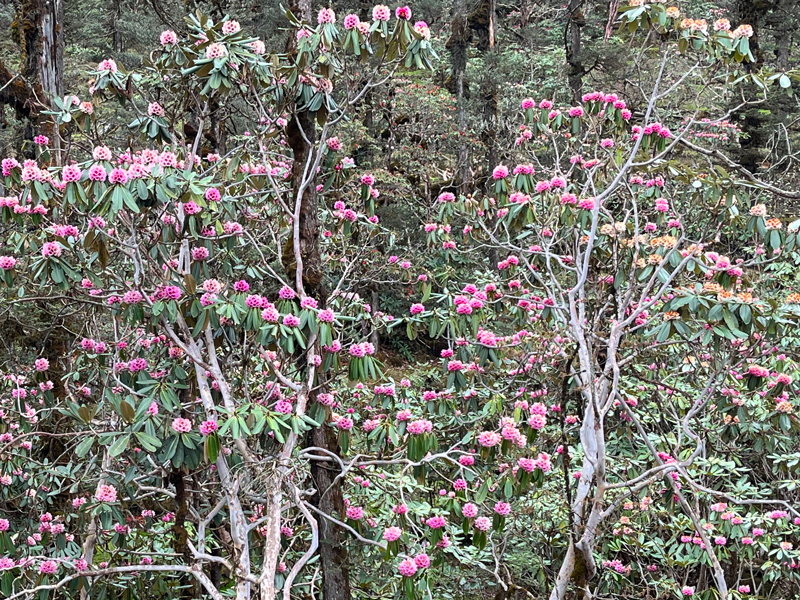
Not long after my sojourn to Dagala, I was given the opportunity to travel to the southern part of Bhutan, next to the Indian border. The Environmental Law Clinic from the Law School were going to Zhemgang Dzongkhag (province) to conduct anti-poaching workshops with local villagers. It was an amazing opportunity for many reasons. First, we travelled by bus (12 hours) and passed through four distinct eco systems. We left the pine and fir forests of Paro and travelled through rhodo country. Thousands and thousands of blooming red rhododendrons growing on mountainsides with a few interspersed trees. Looking across from one mountainside to another the eye is met with a blanket of red hues, rather reminiscent of a French abstract painting. Moving on we arrived in silk tree country with prickly pear cactus and datura plants dotting the roadsides. From there we travelled to the subtropical zone with huge ferns, grasses and banana trees -a rich diversity of plants, animals and birds. Moisture ladened everything, white langurs played in trees and hornbills appeared looking incomprehensible with their huge beaks. There is a fecund feeling to the south as it is hot and moist, the land of elephants and tigers. Before retracing our steps, we were able to take a boat ride down the Mangde River where we spied an elephant just in from the river edge, or rather the elephant spied us. Offering a warning sound – rather like blowing through vibrating lips – the elephant announced his presence as we floated by. The jungle surrounding this amazing creature looked unreal, too perfect, exactly what a Hollywood movie maker would try to create. But here we were looking at the immense beauty of unspoiled nature.
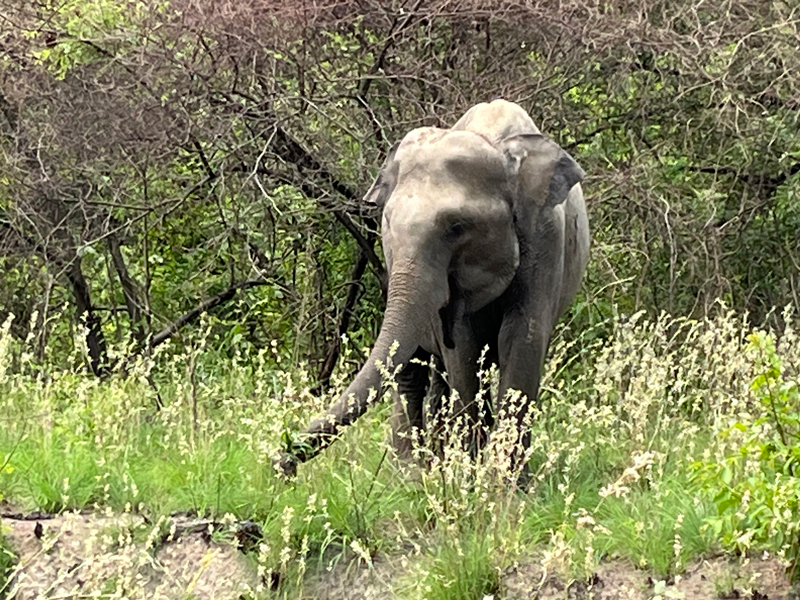
There is much to report about that trip, the tiger paw print in a dry riverbed that we were shown by Park Rangers, a herd of water buffalo traveling over grasslands in Royal Manas National Park. We visited the Tiger Reserve Research Centre and were shown pictures of the tigers in the park that have been captured by 93 different cameras strategically set up to monitor the animals. It was an amazing adventure.

But back to blooming rhodos, one more trip before the rains. I went to the neighbouring Dzonghkag, Haa, the most western district in Bhutan. This area is defined by two things: it is where both China and India border Bhutan in what is known as the chicken neck area. Consequently, in the town of Haa there are two military bases, a Bhutanese army base and and an Indian one. The rest of the region is mostly uninhabited as the landscape is difficult for farming. There are yak herds that are moved up and down the mountains depending on the season but even they are not as numerous as in other parts of the country. The outcome is a landscape that is almost pristine. Rhododendron forests so plentiful, so huge, so tall. While I was there pink rhodos were blooming, tall, old shrubs with trunks that looked like eucalyptus trees and cast a dusty hue through the forests. Thanks to my guide, we spotted the three major pheasants of the region: Satyr Tragopan, Himalayan Monal (a family with four chicks) and Blood Pheasant (male and female). What a day! Our night was spent in the town of Haa, which reminded me of Hope, BC, an old fashioned town nestled in a valley surrounded by mountains covered with trees.
Now, I am back in my village of Pangbisa waiting for the rains.
